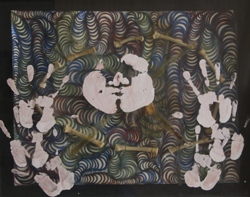 |
"Carlos Villa's "State of State" includes
a chicken head and bones placed over a whirling vortex of tornadolike. It's part of an exhibition
at b. sakata garo.
|
| |
|
From works made with feathers and bones to shallow cases that enclose minimalist grids,
Carlos Villa’s show at b. sakata garo is brilliant and deeply moving. Ranging from
a kind of bib made of oily black feathers and a pair of feather shoes to elegant
and subtle abstract paintings, the show covers a wide range of his remarkable works.
Villa, who died of cancer in March 2013, has been called the most significant
American artist of Filipino descent in the second half of the 20th century.
A longtime professor at the San Francisco Art Institute, he was also an influential
teacher and a multicultural activist in the Bay Area.
His important contributions are chronicled in “Carlos Villa and the Integrity
of Spaces,” a book of essays and images edited by Theodore S. Gonsalves and
published by Meritage Press in San Francisco and St. Helena. It’s a book
any student of Villa’s work should have.
Villa began his career as a student at California School of Fine Arts in
the 1950s and went on to Mills College in Oakland for graduate work.
Seeking his fortune in New York, he became a successful minimalist
artist associated with the Park Place Group in the late 1950s,
but became disillusioned with formalist aesthetics in 1969 when
he returned to San Francisco to begin working toward an art that would reflect
his roots as a second-generation Filipino American.
In works such as “Witnessing” from the 1970s, Villa used chicken bones,
watercolor and blood on paper with handprints and face print on glass
to create a kind of ritualized art-making that drew on Oceanic sources.
Similarly, “State of the State” includes a chicken head and bones
placed over a whirling vortex of tornadolike forms that have a three-dimensional
effect. These works have an hallucinogenic quality and a sense of having needed to be made.
That sense of necessity also imbues “Richter’s Amazing Revelation” in which a gold and
gray grid forms a kind of op-art lattice. It is followed by a series of grid compositions
in subtle tones that are remarkably luminous.
The grid persists in works that mix rectangles and squares with metallic insets
inscribed with words and phrases that are meaningful to Villa because of their
relationship with the Filipino culture of men of his father’s generation, who
were displaced from their roots and struggled to find an identity in mainstream
white culture.
“A Minimalist Stretch” pits matte silver and shiny chrome against each other,
the plates inscribed with barely legible words. “The Blur: Remembering Hotel
Whatever and the Evacuation” is made up of commemorative plaques with haunting
phrases: “Nothing Lasts,” “Empty Promises,” Just Survive,” etc. These works are
laden with sorrow and longing for a sense of belonging in an alien world.
“The Code” and “Man Wandering in a Chinese Landscape” are companion pieces.
In “The Code,” a shallow rectangular case is opened to reveal a black side
and a facing grid of mottled gray markings. It is both elegant and elegiac.
In “Man Wandering …” the case is opened on a white rectangle facing white-on-
white squares, which give it a shining, ebullient feeling, a sense of release.
These masterful pieces were probably made in the early 2000s. I say probably
because one drawback to the show is that no dates are given for any of the
works on view. The other drawback, if you can call it that, is that it leaves
you wanting to see more of Villa’s work, presented in a chronological
and scholarly context. Still, it is a stunning show and one must thank Barry
Sakata for bringing it to Sacramento.
Carlos Villa
WHERE: b. sakata garo, 923 20th St.
WHEN: Noon to 6 p.m. Tuesdays-Saturdays,through May 3
INFORMATION: (916) 447-4276
